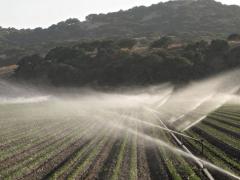Assessing future reactive nitrogen inputs into global croplands based on the shared socioeconomic pathways
Only under the most optimistic sustainability scenario, the global synthetic fertilizer use in croplands stabilizes or even shrinks in the coming decades. In the most pessimistic fragmentation scenario, synthetic fertilization application rates are expected to increase almost threefold by 2050.
Global nitrogen inputs
This article explores future N input requirements and N use efficiency in agriculture for the five shared socioeconomic pathways (SSP). Results show that under the most optimistic sustainability scenario (SSP1), the global synthetic fertilizer use in croplands stabilizes and even shrinks (85 TgNyr−1 in 2050) regardless of the increase in crop production required to feed the larger estimated population. This scenario is highly dependent on projected increases in N use efficiency, particularly in South and East Asia. In the most pessimistic scenario (SSP3, the fragmentation scenario), synthetic fertilization application rates are expected to increase almost threefold by 2050 (260 Tg N yr-1).
This article has a twin which uses the same set of scenarios, but focusing on global phosphorus requirements and fertilizer use.
Nitrogen surpluses
The application of synthetic fertilizers has boosted the global agricultural production demanded by the exploding global population since the late part of the 19th century. Since at the global scale the N in from harvested crops is less than 50% of the fertilizer N applied, the nitrogen use efficiency is low and there are major N losses to the environment. While improvement in agricultural practices and environmental legislation in developed regions such as Western Europe have led to a remarkable increase in the N use efficiency since 1985, this lower requirement for reactive N inputs via synthetic fertilizers has yet to occur in many developing and transition regions. Excepting the sustainability scenario SSP1, all other projected scenarios reveal that the areal N surpluses will exceed acceptable limits in most of the developing regions.
The scenarios
The SSPs include a sustainability scenario (SSP1, coined sustainability) in which the world makes good progress toward reducing our environmental impact. SSP2 (business as usual) typifies the middle of the road pathway, where current trends propagate toward the future. SSP3 (fragmentation) consists of a fragmented world with regions differing widely in economic development. SSP4 (regional inequality) represents a scenario with a highly unequal world. Finally, SSP5 (economic development) concerns a global development that focuses on economic growth with continued high greenhouse gas emissions.
Authors
Specifications
- Publication title
- Assessing future reactive nitrogen inputs into global croplands based on the shared socioeconomic pathways
- Publication date
- 23 March 2018
- Publication type
- Publication
- Magazine
- Environ. Res. Lett. 13 (2018)
- Product number
- 2997




